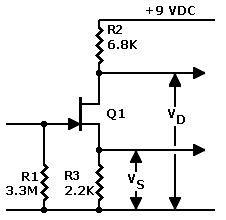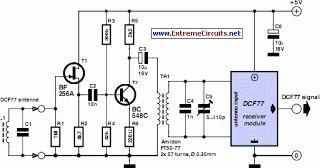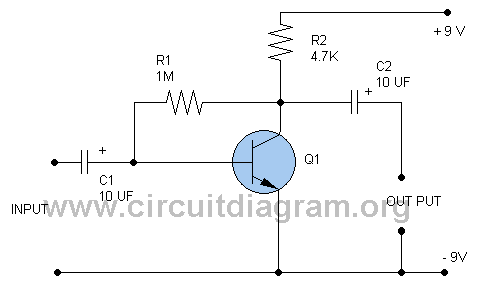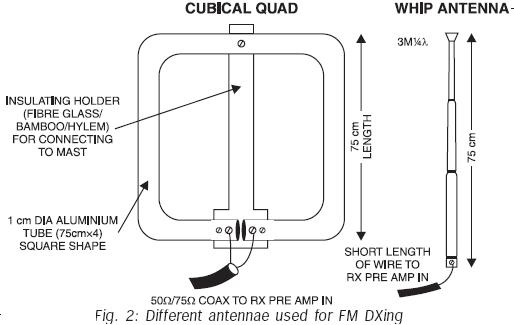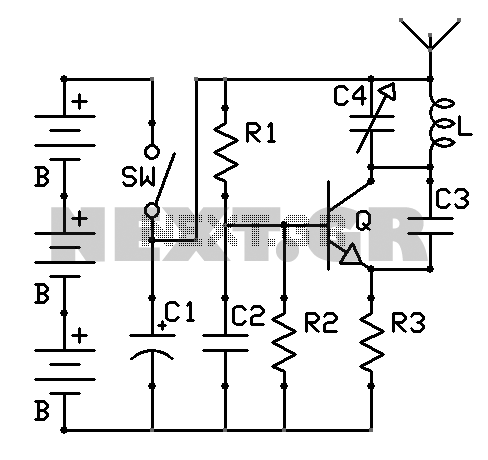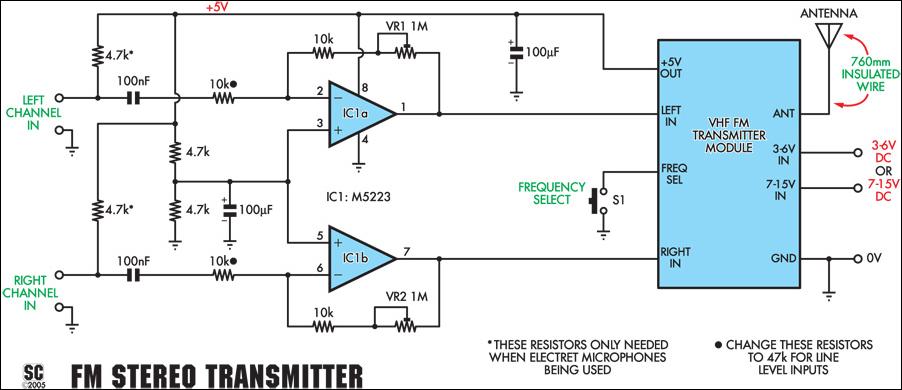
Portable Microphone Preamplifier
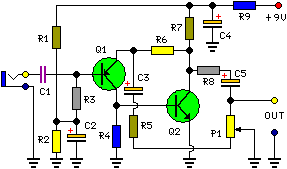
This circuit is primarily designed to provide a microphone input for standard home stereo amplifiers. Utilizing a battery supply minimizes the risk of low-frequency hum interference from mains power, simplifying the connection to the amplifier by eliminating the need for a mains cable and power supply. When using a stereo microphone, the circuit must be duplicated, and it is preferable to use two separate level controls instead of a dual-ganged stereo potentiometer. The circuit operates at a low current draw of approximately 2mA, which contributes to extended battery life. It is built around a low-noise, high-gain two-stage amplifier comprising PNP and NPN transistors, employing DC negative feedback via resistor R6 to maintain stable operating conditions. The output level is adjusted by potentiometer P1, which simultaneously reduces the gain of the stage due to the increased resistance of R5. This unique configuration of P1 facilitates a high headroom input, accommodating a wide range of input sources, from 0.2 to 200mV RMS for a 1V RMS output.
The circuit consists of a two-stage transistor amplifier configuration that enhances the microphone signal before sending it to the home stereo amplifier. The first stage utilizes a PNP transistor, which amplifies the low-level microphone signal. The output of this stage is then fed into an NPN transistor for further amplification. This combination of PNP and NPN transistors ensures low noise and high gain, essential for clear audio reproduction.
The design incorporates a feedback mechanism through resistor R6, which is crucial for stabilizing the amplifier's operating conditions. This feedback loop helps to minimize distortion and maintain linearity across varying input levels. The use of a battery supply not only eliminates potential interference from AC mains but also simplifies the overall power management of the circuit.
For stereo applications, the circuit can be duplicated, allowing for individual control over the left and right audio channels. Each channel can be equipped with its own level control, enhancing the user's ability to balance the audio output as needed. The choice of separate potentiometers instead of a dual-ganged potentiometer offers improved control and flexibility.
The output stage features an adjustable level controlled by potentiometer P1. This potentiometer not only adjusts the output level but also influences the gain of the amplifier stage through resistor R5. By increasing R5's value, the gain is reduced, which is beneficial in preventing clipping and distortion when faced with high input levels. This design allows the circuit to handle a broad range of input signal levels, making it versatile for various microphone types and audio sources.
In summary, this circuit provides a practical solution for integrating a microphone input into home stereo amplifiers, characterized by its low noise, efficient power consumption, and adaptability to different audio sources.This circuit is mainly intended to provide common home stereo amplifiers with a microphone input. The battery supply is a good compromise: in this manner the input circuit is free from mains low frequency hum pick-up and connection to the amplifier is more simple, due to the absence of mains cable and power supply. Using a stereo microphone the ci rcuit must be doubled. In this case, two separate level controls are better than a dual-ganged stereo potentiometer. Low current drawing (about 2mA) ensures a long battery life. The circuit is based on a low noise, high gain two stage PNP and NPN transistor amplifier, using DC negative feedback through R6 to stabilize the working conditions quite precisely. Output level is attenuated by P1 but, at the same time, the stage gain is lowered due to the increased value of R5.
This unusual connection of P1, helps in obtaining a high headroom input, allowing to cope with a wide range of input sources (0. 2 to 200mV RMS for 1V RMS output). 🔗 External reference
The circuit consists of a two-stage transistor amplifier configuration that enhances the microphone signal before sending it to the home stereo amplifier. The first stage utilizes a PNP transistor, which amplifies the low-level microphone signal. The output of this stage is then fed into an NPN transistor for further amplification. This combination of PNP and NPN transistors ensures low noise and high gain, essential for clear audio reproduction.
The design incorporates a feedback mechanism through resistor R6, which is crucial for stabilizing the amplifier's operating conditions. This feedback loop helps to minimize distortion and maintain linearity across varying input levels. The use of a battery supply not only eliminates potential interference from AC mains but also simplifies the overall power management of the circuit.
For stereo applications, the circuit can be duplicated, allowing for individual control over the left and right audio channels. Each channel can be equipped with its own level control, enhancing the user's ability to balance the audio output as needed. The choice of separate potentiometers instead of a dual-ganged potentiometer offers improved control and flexibility.
The output stage features an adjustable level controlled by potentiometer P1. This potentiometer not only adjusts the output level but also influences the gain of the amplifier stage through resistor R5. By increasing R5's value, the gain is reduced, which is beneficial in preventing clipping and distortion when faced with high input levels. This design allows the circuit to handle a broad range of input signal levels, making it versatile for various microphone types and audio sources.
In summary, this circuit provides a practical solution for integrating a microphone input into home stereo amplifiers, characterized by its low noise, efficient power consumption, and adaptability to different audio sources.This circuit is mainly intended to provide common home stereo amplifiers with a microphone input. The battery supply is a good compromise: in this manner the input circuit is free from mains low frequency hum pick-up and connection to the amplifier is more simple, due to the absence of mains cable and power supply. Using a stereo microphone the ci rcuit must be doubled. In this case, two separate level controls are better than a dual-ganged stereo potentiometer. Low current drawing (about 2mA) ensures a long battery life. The circuit is based on a low noise, high gain two stage PNP and NPN transistor amplifier, using DC negative feedback through R6 to stabilize the working conditions quite precisely. Output level is attenuated by P1 but, at the same time, the stage gain is lowered due to the increased value of R5.
This unusual connection of P1, helps in obtaining a high headroom input, allowing to cope with a wide range of input sources (0. 2 to 200mV RMS for 1V RMS output). 🔗 External reference
